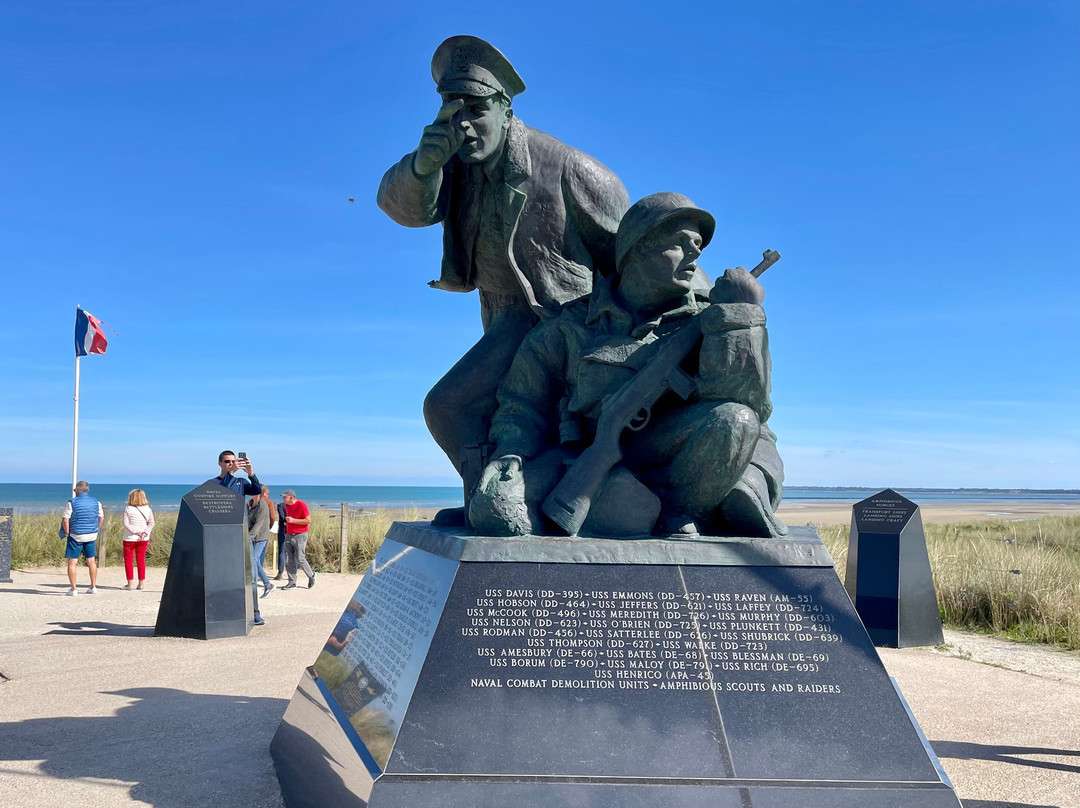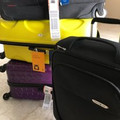的点评
One of the More Dramatic WWII Monuments at Utah Beach
U.S. Navy Monument的点评
点评:This is one of the more dramatic WWII monuments at Utah Beach. It sits on a high point above the dunes and beach and pays tribute to the contribution made by the US Navy in the D-Day landings at Normandy.
Three intertwined figures represent the three main roles played by the Navy.
All are actively engaged in their real-life roles and it’s not hard to see determination and courage etched in their faces.
An officer stands upright, one hand pointing forcefully ahead. He represents leadership and planning. A sailor kneeling down represents the work of the naval combat demolition units. They played a vital role in paving the way for the D-Day landing. Known as ‘Frogmen’, they were a part of Operation Neptune and were sent in ahead of the landing to clear the beach of mines, barbed wire and other anti-landing obstacles. It was painstaking and dangerous work dismantling and defusing the mines and bombs that peppered the beachfront.
The third sailor is loading a gun in readiness for the landing. He would be one of the 23,000 American soldiers who would land here just before dawn, on the 6th June, 1944 and make their way, under heavy German fire.
Below, the names of all the US Navy ships and units involved in the D-Day landings are listed on the base of the monument..
TIP FOR DRIVERS:
There is plenty of free parking in an open area just off the D913. From here, you can easily walk towards the memorials and follow the short, sandy path down to the beach itself.
Three intertwined figures represent the three main roles played by the Navy.
All are actively engaged in their real-life roles and it’s not hard to see determination and courage etched in their faces.
An officer stands upright, one hand pointing forcefully ahead. He represents leadership and planning. A sailor kneeling down represents the work of the naval combat demolition units. They played a vital role in paving the way for the D-Day landing. Known as ‘Frogmen’, they were a part of Operation Neptune and were sent in ahead of the landing to clear the beach of mines, barbed wire and other anti-landing obstacles. It was painstaking and dangerous work dismantling and defusing the mines and bombs that peppered the beachfront.
The third sailor is loading a gun in readiness for the landing. He would be one of the 23,000 American soldiers who would land here just before dawn, on the 6th June, 1944 and make their way, under heavy German fire.
Below, the names of all the US Navy ships and units involved in the D-Day landings are listed on the base of the monument..
TIP FOR DRIVERS:
There is plenty of free parking in an open area just off the D913. From here, you can easily walk towards the memorials and follow the short, sandy path down to the beach itself.
翻译:这是犹他海滩最具戏剧性的二战纪念碑之一。它坐落在沙丘和海滩的高处,向美国海军在诺曼底登陆日所做的贡献致敬。
三个交织在一起的人物代表海军扮演的三个主要角色。
所有人都积极参与他们现实生活中的角色,不难看出他们脸上刻着决心和勇气。
一名军官笔直站立,一只手指着前方。他代表着领导力和规划。一名跪下的水兵代表海军战斗爆破部队的工作。他们在为诺曼底登陆铺平道路方面发挥了至关重要的作用。他们被称为“蛙人”,是海王星行动的一部分,在登陆前被派去清除海滩上的地雷、铁丝网和其他反登陆障碍物。拆除和拆除散布在海滩的地雷和炸弹是一项艰苦而危险的工作。
第三名水手正在装填枪支,准备登陆。他是 1944 年 6 月 6 日黎明前登陆此地并在德军猛烈炮火下前进的 23,000 名美国士兵之一。
下面,纪念碑底座上列出了所有参与 D 日登陆的美国海军舰艇和部队的名称。
司机提示:
D913 附近的空地上有很多免费停车位。从这里,您可以轻松步行前往纪念碑,然后沿着短短的沙路走到海滩。
三个交织在一起的人物代表海军扮演的三个主要角色。
所有人都积极参与他们现实生活中的角色,不难看出他们脸上刻着决心和勇气。
一名军官笔直站立,一只手指着前方。他代表着领导力和规划。一名跪下的水兵代表海军战斗爆破部队的工作。他们在为诺曼底登陆铺平道路方面发挥了至关重要的作用。他们被称为“蛙人”,是海王星行动的一部分,在登陆前被派去清除海滩上的地雷、铁丝网和其他反登陆障碍物。拆除和拆除散布在海滩的地雷和炸弹是一项艰苦而危险的工作。
第三名水手正在装填枪支,准备登陆。他是 1944 年 6 月 6 日黎明前登陆此地并在德军猛烈炮火下前进的 23,000 名美国士兵之一。
下面,纪念碑底座上列出了所有参与 D 日登陆的美国海军舰艇和部队的名称。
司机提示:
D913 附近的空地上有很多免费停车位。从这里,您可以轻松步行前往纪念碑,然后沿着短短的沙路走到海滩。

此点评仅代表旅行者个人的主观意见,并不代表TripAdvisor以及其合作方的意见。
关于我们
|
新闻动态
|
商务合作
|
会员中心
|
业主中心
|
业主通
|
常见问题
|
意见反馈
|
联系我们
|
营业执照
© 2025 Tripadvisor 版权所有。
使用条款 |隐私政策 |网站工作原理
部分照片由 VFM Leonardo 提供。
* Tripadvisor不是旅行社,也不是旅游预订服务代理商。我们提供免费、客观、公正的旅游资讯服务。 (显示更多)
TripAdvisor LLC 既不是预订代理商,也不是旅游运营商,不会向网站用户收取任何服务费。 按照规定,在 Tripadvisor 发布机票价格、游览和旅行套餐的合作伙伴(航空公司、旅行提供商及预订代理商),其标价须包含所有费用和附加费用。 例如, 机场出入境税费、消费税与其他服务费、手续费、杂费及附加费用。 当您向我们的某个合作伙伴进行预订时,请务必查阅他们的网站以了解当地行政部门要求的所有适用费用的具体情况。 除非另有说明,机票价格通常指的是一个人的价格(以人民币计)。
为方便起见,TripAdvisor LLC 根据从我们的预订合作伙伴获取的空房率计算每个酒店的均价。 对于游览和景点来说,所显示价格通常是每位成人的最低可用价格。 对于列出的任何旅行套餐或优惠,TripAdvisor LLC 无法保证任何特定的费率或价格。 此外,酒店均价每晚会更新,并以您的首选币种表示(使用现行汇率)。 由于这些已换算的价格是预估价格,因此,有关具体金额和币种请与预订网站进行核实。
此外,TripAdvisor LLC 无法保证我们网站上宣传的价格随时有效。 标价可能需要预订一定天数才能生效,或有不可用日期、使用条件或限制。
TripAdvisor公司对外部网站的内容一概不负责。优惠价格中不含税和其他费用。
ICP证:沪B2-20200433
沪ICP备20013175号
 沪公网安备31010502005427号
沪公网安备31010502005427号鹰程信息技术(上海)有限公司
货币/国家及地区
¥CNY
中国

